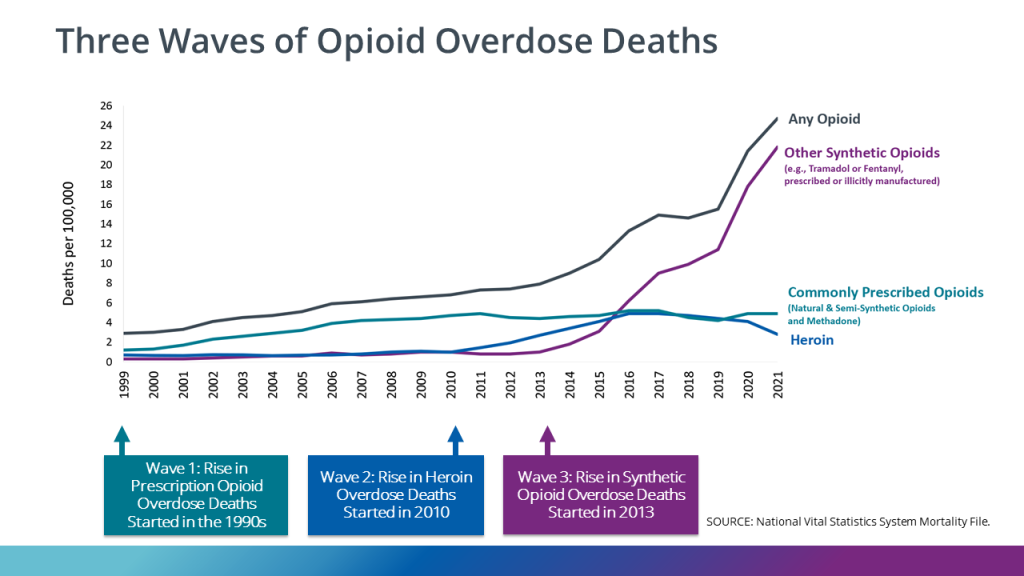Data has emerged as a crucial weapon in the battle against the overdose epidemic in the United States.
Government agencies nationwide are grappling with social issues such as gun violence, gang activity, burglaries and homelessness to go along with the enduring overdose crisis. Addressing these issues requires using data to uncover insights and understanding them to inform policies and programs.
The sobering reality of the overdose epidemic
The overdose epidemic, in particular, has unfolded in waves, steadily claiming lives and leaving a trail of destruction. Despite the US government investing billions of dollars annually for treatment and research, more than 107,000 people died between August 2021 to August 2022 from drug-related causes, according to the CDC. A deeper dive into CDC data reveals an even more shocking statistic: Between 1999 and 2020, over 564,000 people died from an overdose involving any opioid, including prescription and illicit opioids.
Recognizing root causes and employing data for change
While the COVID-19 pandemic contributed to this astounding and horrific number of overdose deaths, the waves of the epidemic began long before that, signifying a deep-rooted problem that requires urgent attention.
Often, the drug data needed to inform policies and programs for this crisis is limited and outdated due to agency cultural, technological, procedural and data policy barriers. This inhibits cross-data analysis, affecting government agencies’ ability to make informed, evidence-based decisions that effectively mitigate or prevent such issues.
Addressing the overdose epidemic requires breaking down these barriers and establishing robust data collection, sharing and analysis frameworks. In doing so, government agencies can gain deeper insights into the dynamics of the epidemic and identify high-risk areas, vulnerable populations and potential root causes.

Aligning policies with realities
Each wave of the epidemic has necessitated a response, resulting in waves of modalities and policies regarding drug prevention, treatment, recovery and enforcement. But have these modalities and policies corresponded with the substances involved in the respective waves? For example, in New Jersey, where the presence of fentanyl in the drug supply was unknown for years, the modalities and policies did not align with the situation. Data and analysis provided the awareness to inform relevant policy decisions, programs and operations. For instance, the authorization for police officers to administer Narcan, a life-saving medication, was based on data insights. Data analysis informs responses to viruses or contaminated water. It can also offer valuable insights for combating drug-related crises.
Challenges and the power of technology
While data is essential, it comes with its own challenges, as the volume, variety and velocity of data are overwhelming. For example, the amount of data generated from the vast array of novel psychoactive substances is monumental. With over 2,600 possible fentanyl-related substances, often mixed with other drugs and cutting agents, tracking these mixtures and their involvement in overdoses and arrests generates a very large amount of data. Safeguarding data privacy and security is important before any analysis is conducted. These insights are vital for decision making, driving effective operations, and developing strategies and programs that save lives, reduce costs and adapt to the ever-changing drug environment.
The future of the overdose epidemic
The fight against the overdose epidemic requires a comprehensive approach and data serves as a guiding light in this endeavor. Leaders can ensure a targeted and effective response by recognizing changes in the drug environment earlier and aligning policies with the substances driving each wave. The challenges posed by the vast amount of data can be met through technology, which helps agencies extract meaningful insights to reduce morbidity and mortality.
Using data and technology, we can drive informed decision making, allocate resources accurately, develop timely response efforts and ultimately make significant strides in combating the overdose epidemic. We all can work together toward a future where lives are saved and the impacts of drug-related harm are minimized.

